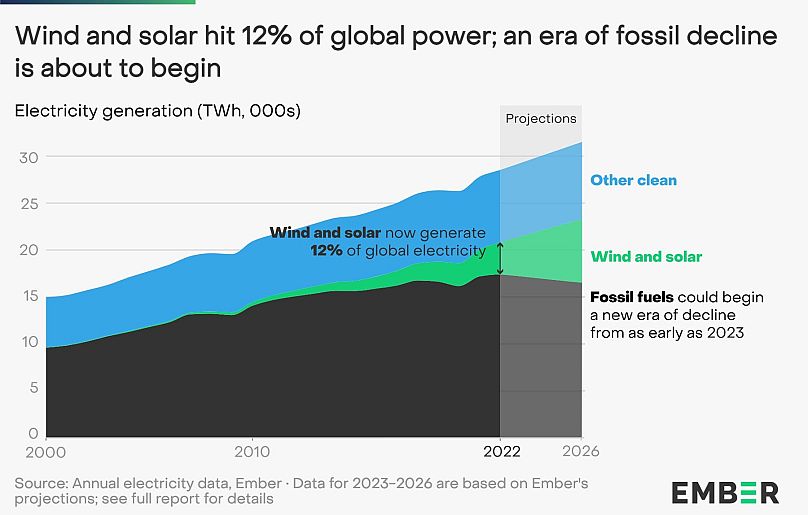Coal is still the single largest source of electricity - but change is coming fast says Ember, with solar rising by 24% in 2022.
Experts are calling time on the fossil age as new analysis shows wind and solar power produced a record amount of the world’s electricity last year.
The renewables generated 12 per cent of global electricity in 2022, up from 10 per cent the previous year, according to the report from clean energy think tank Ember.
And while a small increase in coal burning pushed electricity emissions up to an all-time high, analysts predict this will be the peak of pollution.
“In this decisive decade for the climate, it is the beginning of the end of the fossil age,” says lead author Małgorzata Wiatros-Motyka. “We are entering the clean power era.”
If clean power meets all new demand this year as expected, Ember’s fourth annual Global Electricity Review forecasts a small fall in fossil generation in 2023. Larger falls are set to follow, as wind and solar deployment ramps up.
How are electricity sources getting greener?
Last year, solar was the fastest-growing source of electricity for the 18th year in a row, rising by 24 per cent from 2021. Ember estimates that sun-powered renewables added enough electricity to power all of South Africa.
Wind generation, meanwhile, soared by 17 per cent; enough to power almost all of the UK.
Altogether, clean electricity sources (renewables and nuclear) reached 39 per cent of global electricity. Hydropower produced 15 per cent of this new record, according to Ember’s data.
Despite this progress, coal power remained the single largest source of electricity worldwide, producing 36 per cent of all power in 2022.
But - as Ember’s head of data insights Dave Jones explained previously - the feared return to coal during the global gas crisis never happened.
The growth in wind and solar generation met an impressive 80 per cent of the rise in global electricity demand last year, helping to keep the fossil fuel in the ground. Coal generation rose by only 1.1 per cent, and gas power fell by a very slight 0.2 per cent.
“The stage is set for wind and solar to achieve a meteoric rise to the top,” adds Wiatros-Motyka.
“Clean electricity will reshape the global economy, from transport to industry and beyond. A new era of falling fossil emissions means the coal power phasedown will happen, and the end of gas power growth is now within sight.”
Which countries produce the most electricity from clean energy?
“Change is coming fast,” the senior electricity analyst adds - and quicker in some countries than others.
Ember looked at electricity data from 78 countries, representing 93 per cent of global electricity demand. It reveals that over sixty countries now generate more than 10 per cent of their energy from wind and solar.
A number of European countries are surging ahead. Denmark had the biggest proportion of wind and solar power in its electricity mix at 60.8 per cent last year. Lithuania and Luxembourg follow with 48.4 and 46.6 per cent respectively, though this represents a relatively small amount of power in Terawatt-hour (TWh) terms.
By this metric, Germany produced the most wind and solar power of any European country at 185 TWh, followed by Spain and the UK.
Europe as a whole generated 805 TWh of electricity from wind and solar, which is dwarfed by China at 1,241 TWh (14 per cent of the country’s electric generation).
“China is the 800 pound gorilla when it comes to the global power sector,” comments Li Shuo, senior policy advisor at Greenpeace East Asia.
“This is not only because of China's sheer scale but also a concerning trend of its electricity sector development.
“China has no doubt been leading global renewable energy expansion. But at the same time, the country is accelerating coal project approval.”
The US, India, and Japan have also made some of the largest contributions to the global solar PV capacity, notes Dr Ajay Mathur, director general at the International Solar Alliance.
But Damilola Ogunbiyi, CEO and Special Representative of the UN Secretary-General for Sustainable Energy for All, sounds a cautionary note about the just rollout of renewables.
“Global progress, while encouraging, doesn't reveal the growing disparity in renewable energy adoption which is tipped disproportionately in favour of developed countries and emerging economies in Asia,” Ogunbiyi, who is also co-chair of UN-Energy, says.
“Much more needs to be done to ensure that developing countries are not left behind and locked into high carbon futures.”
Is the world on track for net zero electricity?
Electricity is the world’s highest emitting sector and decarbonising it is the bedrock of a net zero energy system.
According to modelling by the International Energy Agency, electricity must be the first sector to reach net zero by 2040 in order to achieve economy-wide net zero by 2050. That would mean wind and solar hitting 41 per cent of global electricity by 2030 - a steep improvement on 12 per cent last year.
Ember says it all depends on the actions taken now by governments, businesses and citizens to put the world on a pathway to clean power.
The endurance of coal means “the power sector remains off-track in meeting net zero targets globally by mid-century,” says Ogunbiyi.
But the good news is that we have the technology we need. “The way forward lies in pacing up renewable energy and making renewable energy technology a global public good,” says Dr Mathur.
To address some of the challenges, he advocates for stronger policies on easing finance and improving access to components and raw materials, as well as greater geographical diversification of the supply chain.
“In addition, continuous capacity building, shifting energy subsidies from fossil fuels to renewable energy, and solar mini-grids would make for faster movement towards universal energy access.”













